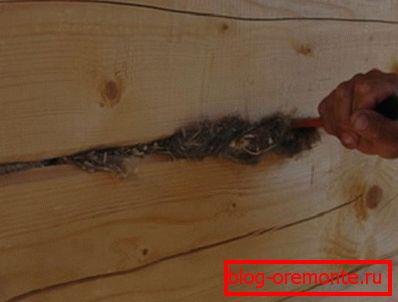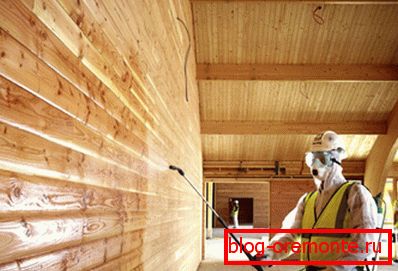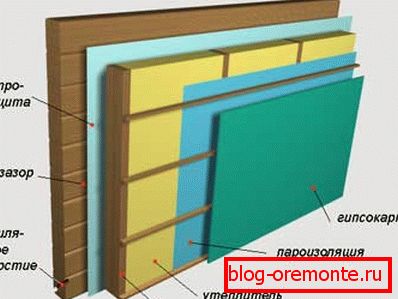Warming from the inside of the house from a bar: features,
Designing a house of bars without fail provides for insulation outside or inside. The microclimate of the structure, the level of humidity, which is vital for human well-being, depends on it.
Comparing with houses made of stone, silicate blocks, bricks, the insulation of a log house from the inside has its own specific features.

Preliminary work
For the implementation of the work you will need:
- special tool;
- vapor barrier film;
- heat insulation materials;
- instructions for work;
- preliminary preparation.

It is possible to ensure perfect warming of walls from a timber from the inside only after high-quality surface preparation (also read the article Covering a Timber from the Inside: Secrets, Tips, Recommendations).
It is necessary to eliminate:
- cracks;
- gaps;
- chipped.
It is strongly recommended that special attention be paid to the condition of the walls, to assess the quality of the insulation work already performed, if any. The choice of material and further actions depend on the quality of processing of joints, junctions of bars, corners.

The most common defects are:
- lack of insulation material;
- a history of the hemp layer.
Do not neglect the recommendations regarding their elimination, otherwise there is a high probability that the insulation works will be repeated.
Attention! All work on wall insulation will be negated in the absence of basement insulation, which is desirable to do at the stage of the excavation. If the foundation is not insulated, you will need to dig it out and insulate it.
Features of the preparatory work

The most common materials used to correct chips, cracks and other defects are:
- flax or jute fiber;
- polymeric compositions;
- polyurethane foam.
Do not neglect this step, relying on the properties of the used advanced finishing materials and the quality of the bars. Compliance with construction technology - the basis of a successful result.
The most common mistake that accompanies the insulation of the walls of a log house from the inside is an attempt to speed up the process. Even the most expensive material is not able to retain heat in the room unless all possible defects arising during the shrinking process are sealed.
To eliminate the gaps need to carry out the following work:
- thicken;
- конпатить.

One of the most popular and affordable materials used to seal the cracks is jute fiber. If you carry out the work with your own hands, you will need a special chisel, with its help to easily fill the grooves.
For large gaps, tape tow is an ideal option, which should be twisted into a roller.
Wood processing

Warming of a log house inside provides for compliance with mandatory sanitary and hygienic requirements that prevent the spread of fungi and mold. There are more than enough antiseptics of various cost on sale, which are recommended to be purchased in accordance with the specific features of the climate.
Antifungal agent must be carefully processed every centimeter, special attention paid to hard-to-reach places: cracks, corners. If necessary, the treatment should be carried out twice (see also the article Timber and larch, especially the sawn timber from this tree).
Stages of insulation

Selection of materials
Requirements for materials used for insulation:
- ease of use;
- environmental friendliness;
- safety for humans and the environment;
- fire safety;
- durability.
For work it is necessary to purchase only safe materials that prevent negative effects on people. To this end, it is necessary to carefully study the factory instructions, which contain comprehensive information, including on the installation.
There are special heat-insulating materials covered with film in the production process, their price is correspondingly different, however, the advantage is obvious: the reduction in the duration of the installation works and the lack of costs for vapor barrier.
Attention! Thermal insulation of the bath from the inside of the timber is carried out according to the same rules as the insulation of the house. Only materials need to select those on the state of which is not affected by high temperature.
Vapor barrier walls
If heat insulation without a film is used, after the preparatory work, you can safely proceed to the vapor barrier. The main purpose of this stage is to prevent condensation of moisture on the surface of the walls due to sudden temperature changes.
The traditional method of vapor barrier, providing the desired effect and having a small price, is a vapor barrier film.
High-quality vapor barrier eliminates the deposition of excess moisture. The spread of fungus and mold is excluded. Carrying out this type of work will ensure a long operational period of the structure, normal microclimate in the room.
Floor insulation

In addition to the walls, the insulation of the house from a bar 150x150 from the inside provides for carrying out the corresponding work with the floor. This type of work is considered mandatory from the moment of the appearance of the first houses from the timber. Heated floor reduces total heat loss by 20%, this is a very high figure in construction.
The most simple and affordable option is to insulate the floor with mineral wool, if for some reason the floor is already covered, without hesitation, dismantle, otherwise it will be very problematic to retain heat. First of all, lining the subfloor, waterproofing film and insulation are laid on it. Popular polystyrene foam.
When a columnar or pile foundation is recommended to warm the entire space under the house.
This requires advance preparation:
- it is necessary to make falling asleep and leveling the gravel cushion, approximately 40 cm;
- the formation is thoroughly compacted;
- sand is poured from above - 10 cm;
- reinforced concrete is poured in, which takes about two weeks to dry completely;
- polyethylene film is laid on the finished base and only after that polystyrene.
Thermal insulation of ceilings

Providing thermal insulation of the ceiling is not less significant stage, especially in areas with northern climatic conditions.
The most common materials for which work does not require special training are:
- polyplex or foam;
- polyethylene foam;
- min;
- keramzit.
In addition to the special modern materials, many prefer the classic version - sawdust.
The advantages of this material are obvious:
- availability;
- environmental friendliness;
- ease of use.
To ensure the long operational life of sawdust, it is imperative to use a special antifungal agent, it is also useful to use a fire retardant to increase fire resistance.
Conclusion
We hope that we were able to highlight in detail the process of warming wooden houses (see also the article How to choose the interior design of a wooden house from a bar). In the presented video in this article you will find additional information on this topic.